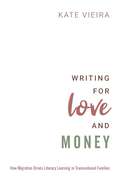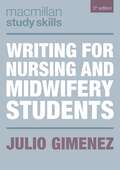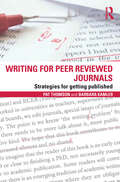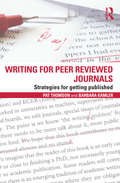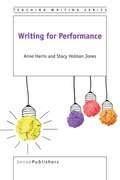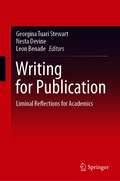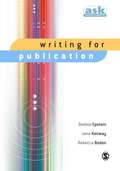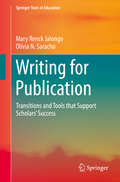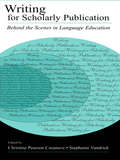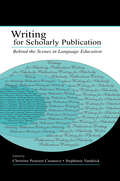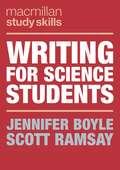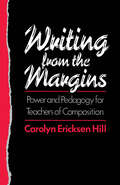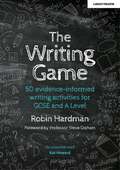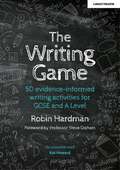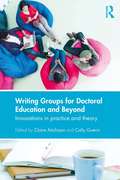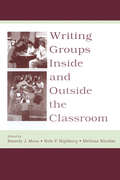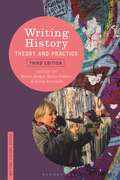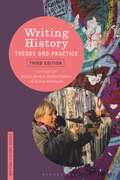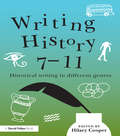- Table View
- List View
Writing for Love and Money: How Migration Drives Literacy Learning in Transnational Families
by Kate VieiraThis book tells the story of how families separated across borders write--and learn new ways of writing--in pursuit of love and money. According to the UN, 244 million people currently live outside their countries of birth. The human drama behind these numbers is that parents are often separated from children, brothers from sisters, lovers from each other. Migration, undertaken in response to problems of the wallet, also poses problems for the heart. Writing for Love and Money shows how families separated across borders turn to writing to address these problems. Based on research with transnational families in Latin America, Eastern Europe, and North America, it describes how people write to sustain meaningful relationships across distance and to better their often impoverished circumstances. Despite policy makers' concerns about "brain drain," the book reveals that immigrants' departures do not leave homelands wholly educationally hobbled. Instead, migration promotes experiences of literacy learning in transnational families as they write to reach the two life goals that globalization consistently threatens: economic solvency and familial intimacy.
WRITING FOR LOVE & MONEY C: How Migration Drives Literacy Learning in Transnational Families
by Kate VieiraThis book tells the story of how families separated across borders write--and learn new ways of writing--in pursuit of love and money. According to the UN, 244 million people currently live outside their countries of birth. The human drama behind these numbers is that parents are often separated from children, brothers from sisters, lovers from each other. Migration, undertaken in response to problems of the wallet, also poses problems for the heart. Writing for Love and Money shows how families separated across borders turn to writing to address these problems. Based on research with transnational families in Latin America, Eastern Europe, and North America, it describes how people write to sustain meaningful relationships across distance and to better their often impoverished circumstances. Despite policy makers' concerns about "brain drain," the book reveals that immigrants' departures do not leave homelands wholly educationally hobbled. Instead, migration promotes experiences of literacy learning in transnational families as they write to reach the two life goals that globalization consistently threatens: economic solvency and familial intimacy.
Writing for Nursing and Midwifery Students (Macmillan Study Skills)
by Julio GimenezCombining a theoretical approach with practical activities, this book is invaluable for nursing and midwifery students and will help them to master the basics of writing at university. It equips students with the skills needed to examine cognitive processes such as reflection and critical thinking and includes essential information on referencing correctly and avoiding plagiarism. Going beyond the traditional essay, it provides support and guidance on producing care critiques, action plans, portfolios and journal article reviews alongside complex argumentative writing and undergraduate dissertation proposals. Written in an engaging and accessible style, this is a comprehensive writing toolkit for students of nursing, midwifery, health and social care. Suitable for students of all levels, it is ideal for use in class or for independent study.
Writing for Peer Reviewed Journals: Strategies for getting published
by Pat Thomson Barbara KamlerIt’s not easy getting published, but everyone has to do it. Writing for Peer Reviewed Journals presents an insider’s perspective on the secret business of academic publishing, making explicit many of the dilemmas and struggles faced by all writers, but rarely discussed. Its unique approach is theorised and practical. It offers a set of moves for writing a journal article that is structured and doable but also attends to the identity issues that manifest on the page and in the politics of academic life. The book comprehensively assists anyone concerned about getting published; whether they are early in their career or moving from a practice base into higher education, or more experienced but still feeling in need of further information. Avoiding a ‘tips and tricks’ approach, which tends to oversimplify what is at stake in getting published, the authors emphasise the production, nurture and sustainability of scholarship through writing – a focus on both the scholar and the text or what they call text work/identity work. The chapters are ordered to develop a systematic approach to the process, including such topics as: The writer The reader What’s the contribution? Beginning work Refining the argument Engaging with reviewers and editors Writing for Peer Reviewed Journals uses a wide range of multi-disciplinary examples from the writing workshops the authors have run in universities around the world: including the UK, Canada, Australia, New Zealand, Ireland, South Africa, Norway, Sweden, Denmark and the United States. This international approach coupled with theoretically grounded strategies to guide the authoring process ensure that people at all stages of their career are addressed. This lively book uses a combination of personal stories, student texts, published journal abstracts and excerpts from interviews with journal editors and publishers. Written in an accessible style, one which does not use the patronising ‘you’ of advice books, it offers a collegial approach to a task which is difficult for most scholars, regardless of their years of experience.
Writing for Peer Reviewed Journals: Strategies for getting published
by Pat Thomson Barbara KamlerIt’s not easy getting published, but everyone has to do it. Writing for Peer Reviewed Journals presents an insider’s perspective on the secret business of academic publishing, making explicit many of the dilemmas and struggles faced by all writers, but rarely discussed. Its unique approach is theorised and practical. It offers a set of moves for writing a journal article that is structured and doable but also attends to the identity issues that manifest on the page and in the politics of academic life. The book comprehensively assists anyone concerned about getting published; whether they are early in their career or moving from a practice base into higher education, or more experienced but still feeling in need of further information. Avoiding a ‘tips and tricks’ approach, which tends to oversimplify what is at stake in getting published, the authors emphasise the production, nurture and sustainability of scholarship through writing – a focus on both the scholar and the text or what they call text work/identity work. The chapters are ordered to develop a systematic approach to the process, including such topics as: The writer The reader What’s the contribution? Beginning work Refining the argument Engaging with reviewers and editors Writing for Peer Reviewed Journals uses a wide range of multi-disciplinary examples from the writing workshops the authors have run in universities around the world: including the UK, Canada, Australia, New Zealand, Ireland, South Africa, Norway, Sweden, Denmark and the United States. This international approach coupled with theoretically grounded strategies to guide the authoring process ensure that people at all stages of their career are addressed. This lively book uses a combination of personal stories, student texts, published journal abstracts and excerpts from interviews with journal editors and publishers. Written in an accessible style, one which does not use the patronising ‘you’ of advice books, it offers a collegial approach to a task which is difficult for most scholars, regardless of their years of experience.
Writing for Performance (Teaching Writing)
by Anne Harris Stacy Holman - Jones"The Teaching Writing series publishes user-friendly writing guides penned by authors with publishing records in their subject matter. Harris and Holman Jones offer readers a practical and concise guide to writing a variety of dynamic texts for performance ranging from playscripts to ensemble and multimedia/hybrid works. Writing for Performance is structured around the ‘tools’ of performance writing—words, bodies, spaces, and things. These tools serve as pivots for understanding how writing for performance must be conducted in relation to other people, places, objects, histories, and practices. This book can be used as a primary text in undergraduate and graduate classes in playwriting, theatre, performance studies, and creative writing. It can also be read by ethnographic, arts-based, collaborative and community performance makers who wish to learn the how-to of writing for performance. Teachers and facilitators can use each chapter to take their students through the conceptualizing, writing, and performing/creating process, supported by exemplars and writing exercises and/or prompts so readers can try the form themselves.“What a welcome, insightful and much-needed book. Harris and Holman Jones bring us to an integrated notion of writing that is embodied, felt, breathed and flung from stage to page and back again. Writing for Performance will become a crucial text for the creation of the performance and theater that the 21st Century will need.” – Tim Miller, artist and author of Body Blows: Six Performances and 1001 Beds: Performances, Essays and Travels “No prescriptions here. In the hands of this creative duo we find a deep and abiding respect for the many creative processes that might fuel writing and performance that matters. From the deep wells of their own experiences, Harris and Holman Jones offer exercises that are not meant to mold the would-be writer, but spur them on to recognize their latent writing/performative selves.” – Kathleen Gallagher, Distinguished Professor of Curriculum, Teaching, and Learning, University of TorontoAnne Harris, PhD, is a senior lecturer at Monash University (Melbourne), and researches in the areas of arts, creativity, performance, and diversity.Stacy Holman Jones, PhD, is Professor in the Centre for Theatre and Performance at Monash University (Melbourne) specializing in performance studies, gender and critical theory and critical qualitative methods."
Writing for Publication: Liminal Reflections for Academics
by Leon Benade Georgina Tuari Stewart Nesta DevineThis book focuses on academic writing and how academics who are experts in their fields can translate their expertise into publishable form. The magnitude and speed of the changes that are transforming the global academic landscape produce an ongoing need for literature that interprets the nature of academic work. This book arises from the background discipline of Education, which is a relatively new university subject that draws on the entire knowledge spectrum from the fine arts to the natural sciences. Each chapter addresses an aspect of the conditions of written academic labour in an age of digital publishing: its nature, how it works, and guidance for successful navigation. This book will provide helpful guidance to graduate students, researchers and teachers in universities and higher education, who are united by the challenges of this new world of academic publishing.
Writing for Publication
by Debbie Epstein Jane Kenway Professor Rebecca BodenWriting for Publication deals with a number of generic issues around academic writing (including intellectual property rights) and then considers writing refereed journal articles, books and book chapters in detail as well as other, less common, forms of publication for academics. The aim is to demystify the process and to help you to become a confident, competent, successful and published writer.
Writing for Publication: Transitions and Tools that Support Scholars’ Success (Springer Texts in Education)
by Mary Renck Jalongo Olivia N. SarachoThis book offers systematic instruction and evidence-based guidance to academic authors. It demystifies scholarly writing and helps build both confidence and skill in aspiring and experienced authors. The first part of the book focuses on the author’s role, writing’s risks and rewards, practical strategies for improving writing, and ethical issues. Part Two focuses on the most common writing tasks: conference proposals, practical articles, research articles, and books. Each chapter is replete with specific examples, templates to generate a first draft, and checklists or rubrics for self-evaluation. The final section of the book counsels graduate students and professors on selecting the most promising projects; generating multiple related, yet distinctive, publications from the same body of work; and using writing as a tool for professional development. Written by a team that represents outstanding teaching, award-winning writing, and extensive editorial experience, the book leads teacher/scholar/authors to replace the old “publish or perish” dictum with a different, growth-seeking orientation: publish and flourish.
Writing for Publication (PDF)
by Professor Rebecca Boden Jane Kenway Debbie EpsteinWriting for Publication deals with a number of generic issues around academic writing (including intellectual property rights) and then considers writing refereed journal articles, books and book chapters in detail as well as other, less common, forms of publication for academics. The aim is to demystify the process and to help you to become a confident, competent, successful and published writer.
Writing for Scholarly Publication: Behind the Scenes in Language Education
by Christine Pears Casanave Stephanie VandrickThis collection of first-person essays by established authors provides a wealth of support and insights for new and experienced academic writers in language education and multicultural studies. Although writing for publication is becoming increasingly important as these fields become both more professional and more competitive, few scholars talk candidly about their experiences negotiating a piece of writing into print. These essays will help researchers, practitioners, and graduate students expand their understanding of what it means--professionally and personally--to write for publication. Carefully crafted, focused, and provocative, the chapters in this volume document authors' experiences with a range of practical, political, and personal issues in writing for publication. Many portray the hardship and struggle that are not obvious in a finished piece of writing. Readers are encouraged to resonate with the events and issues portrayed, and to connect the narratives to their own lives. Practical information, such as contact information for journal and book publishers, manuscript guidelines, and useful books are included in appendices. Although organized thematically, the essays in Writing for Scholarly Publication: Behind the Scenes in Language Education overlap in many ways as each author considers multiple issues: *In the Introduction, the editors discuss key aspects of writing for scholarly publication, such as writing as situated practice, issues faced by newcomers, the construction of personal identity through writing, writing and transparency, facets of the interactive nature of scholarly writing, and intertwined political issues. *Part I focuses on issues and concerns faced by "Newcomers." *In Part II, "Negotiating and Interacting," the essays closely examine the interactions among authors, editors, manuscript reviewers, and collaborators; these interactions tend to be the least often discussed and these essays therefore offer readers fascinating insights into the sensitive social, political, and personal relationships among the many players in the scholarly writing game. *"Identity Construction" is addressed in Part III, where authors share their experiences with and reflections on the ways that professional writing helps them construct their identities as writers and scholars. *The essays in Part IV, "From the Periphery," help redefine what the notion of "periphery" might mean, from a concept with a negative connotation of "outsider" to a positive connotation of active and unconventional participant.
Writing for Scholarly Publication: Behind the Scenes in Language Education
by Christine Pearson Casanave Stephanie VandrickThis collection of first-person essays by established authors provides a wealth of support and insights for new and experienced academic writers in language education and multicultural studies. Although writing for publication is becoming increasingly important as these fields become both more professional and more competitive, few scholars talk candidly about their experiences negotiating a piece of writing into print. These essays will help researchers, practitioners, and graduate students expand their understanding of what it means--professionally and personally--to write for publication. Carefully crafted, focused, and provocative, the chapters in this volume document authors' experiences with a range of practical, political, and personal issues in writing for publication. Many portray the hardship and struggle that are not obvious in a finished piece of writing. Readers are encouraged to resonate with the events and issues portrayed, and to connect the narratives to their own lives. Practical information, such as contact information for journal and book publishers, manuscript guidelines, and useful books are included in appendices. Although organized thematically, the essays in Writing for Scholarly Publication: Behind the Scenes in Language Education overlap in many ways as each author considers multiple issues: *In the Introduction, the editors discuss key aspects of writing for scholarly publication, such as writing as situated practice, issues faced by newcomers, the construction of personal identity through writing, writing and transparency, facets of the interactive nature of scholarly writing, and intertwined political issues. *Part I focuses on issues and concerns faced by "Newcomers." *In Part II, "Negotiating and Interacting," the essays closely examine the interactions among authors, editors, manuscript reviewers, and collaborators; these interactions tend to be the least often discussed and these essays therefore offer readers fascinating insights into the sensitive social, political, and personal relationships among the many players in the scholarly writing game. *"Identity Construction" is addressed in Part III, where authors share their experiences with and reflections on the ways that professional writing helps them construct their identities as writers and scholars. *The essays in Part IV, "From the Periphery," help redefine what the notion of "periphery" might mean, from a concept with a negative connotation of "outsider" to a positive connotation of active and unconventional participant.
Writing for Science Students (Macmillan Study Skills)
by Jennifer Boyle Scott RamsayWriting for Science Students is a practical guide to the techniques you need for accurate, clear and effective writing. This book takes you through each stage of the process, from understanding the requirements of your assignment and planning your research, right through to reading, structuring your writing and editing. It will equip you with the key skills you need to complete all types of assignments, including essays, lab reports, posters and dissertations.
Writing for University: Vocabulary For Writing At University (Pocket Study Skills)
by Jeanne GodfreyThis indispensable guide shows students what successful academic writing involves and gives them the tools they will need to write successfully themselves. It separates fact from fiction and takes students through the five essential elements of academic writing: writing critically, using sources, developing your own voice, having a clear structure and style and editing drafts. This book is an essential resource for students making the transition to university-level study and a valuable reference point for all students doing academic study in English. It is suitable for students of all disciplines, from education and business through to social work and psychology.
Writing from the Margins: Power and Pedagogy for Teachers of Composition
by Carolyn Ericksen HillToo often both composition teachers and their students experience knowledge and authority as unchanging entities that cannot be challenged in classroom exchanges. Drawing on feminist, cultural, and poststructuralist theory, as well as work in the rhetorical tradition and composition studies, Hill offers less debilitating methods of thinking that teachers can model for their students. Richly illustrated with examples of classroom interactions and student work, the book also shows teachers how to enrich their own intellectual and political lives within the academy.
The Writing Game: 50 Evidence-Informed Writing Activities for GCSE and A Level
by Robin HardmanAs every humanities or social science teacher knows, success in exam years relies on pupils' ability to blend subject knowledge with writing skills. But teachers face two significant problems in developing writing in their classroom: many pupils regard writing practice as a chore or a punishment; and research on writing instruction remains difficult for busy teachers to access. The Writing Game: 50 Evidence-Informed Writing Activities for GCSE and A Level aims to solve these problems by providing a must-read practical toolkit for teachers looking to help their pupils to write their way into the top grades, offering a menu of engaging lesson activities that can be modified to suit any subject context. With activities covering modelling, practice, and feedback, The Writing Game supports teachers to deliver research-informed strategies at every stage of the learning process. Perfect for teachers, middle leaders, and senior leaders, The Writing Game also contains tips on how to incorporate writing practice into regular subject content, formative assessment, and retrieval practice. Each activity is fully explained and accompanied by top tips for maximising effective learning, suggested adaptations, and links to appropriate research. Activities range from rapid five-minute starters and plenaries to whole-lesson extended writing tasks, with plenty in between, and busy teachers will be relieved to hear that many require very little preparation.
The Writing Game: 50 Evidence-Informed Writing Activities for GCSE and A Level
by Robin HardmanAs every humanities or social science teacher knows, success in exam years relies on pupils’ ability to blend subject knowledge with writing skills. But teachers face two significant problems in developing writing in their classroom: many pupils regard writing practice as a chore or a punishment; and research on writing instruction remains difficult for busy teachers to access. The Writing Game: 50 Evidence-Informed Writing Activities for GCSE and A Level aims to solve these problems by providing a must-read practical toolkit for teachers looking to help their pupils to write their way into the top grades, offering a menu of engaging lesson activities that can be modified to suit any subject context. With activities covering modelling, practice, and feedback, The Writing Game supports teachers to deliver research-informed strategies at every stage of the learning process. Perfect for teachers, middle leaders, and senior leaders, The Writing Game also contains tips on how to incorporate writing practice into regular subject content, formative assessment, and retrieval practice. Each activity is fully explained and accompanied by top tips for maximising effective learning, suggested adaptations, and links to appropriate research. Activities range from rapid five-minute starters and plenaries to whole-lesson extended writing tasks, with plenty in between, and busy teachers will be relieved to hear that many require very little preparation.
Writing Groups for Doctoral Education and Beyond: Innovations in practice and theory
by Claire Aitchison Cally GuerinWriting is the principal means by which doctoral candidature is monitored and measured; this, combined with the growing tendency to use publications as proxy measures of individual and institutional productivity, underlines the centrality of writing in academia. One of the central questions for scholars in higher education, therefore, is ‘How do we make writing happen?’, and it is this question which the book seeks to answer. The book provides detailed illustrations of collaborative writing pedagogies which are powerfully enabling, and through theoretical and conceptual interrogation of these practices, the authors point the way for individuals as well as institutions to establish writing groups that are lively, responsive and context-specific. Key topics include: new pedagogical responses for increased writing productivity and the ‘push to publish’; innovations for supporting academic writing quality, confidence and output; scaffolding the thesis writing process; new theoretical explorations of collaborative writing approaches; writing group formulations and pedagogical approaches; writing groups for non-native speakers of English; writing as women in higher education. A particular strength of this book is that it showcases the potential of writing groups for advanced academic writing by pulling together a unique mix of authors and scholarly approaches, representing a wide range of new theoretical and pedagogical frames from diverse countries. Writing Groups for Doctoral Education and Beyond will be attractive to academics seeking new ways to advance their writing productivity, doctoral students, their supervisors and those who are tasked with the job of supporting them through the completion and dissemination of their research.
Writing Groups for Doctoral Education and Beyond: Innovations in practice and theory
by Claire Aitchison Cally GuerinWriting is the principal means by which doctoral candidature is monitored and measured; this, combined with the growing tendency to use publications as proxy measures of individual and institutional productivity, underlines the centrality of writing in academia. One of the central questions for scholars in higher education, therefore, is ‘How do we make writing happen?’, and it is this question which the book seeks to answer. The book provides detailed illustrations of collaborative writing pedagogies which are powerfully enabling, and through theoretical and conceptual interrogation of these practices, the authors point the way for individuals as well as institutions to establish writing groups that are lively, responsive and context-specific. Key topics include: new pedagogical responses for increased writing productivity and the ‘push to publish’; innovations for supporting academic writing quality, confidence and output; scaffolding the thesis writing process; new theoretical explorations of collaborative writing approaches; writing group formulations and pedagogical approaches; writing groups for non-native speakers of English; writing as women in higher education. A particular strength of this book is that it showcases the potential of writing groups for advanced academic writing by pulling together a unique mix of authors and scholarly approaches, representing a wide range of new theoretical and pedagogical frames from diverse countries. Writing Groups for Doctoral Education and Beyond will be attractive to academics seeking new ways to advance their writing productivity, doctoral students, their supervisors and those who are tasked with the job of supporting them through the completion and dissemination of their research.
Writing Groups Inside and Outside the Classroom (International Writing Centers Association (IWCA) Press Series)
by Beverly J. Moss Nels P. Highberg Melissa NicolasThis unique collection considers the nature of writing groups inside and outside the academic environment. Exploring writing groups as contextual literacy events, editors Beverly J. Moss, Nels P. Highberg, and Melissa Nicolas bring together contributors to document and reflect on the various types of collaborations that occur in writing groups in a wide range of settings, both within and outside the academy. The chapters in this volume respond to a variety of questions about writing groups, including: *What is the impact of gender, race, and socioeconomic class on power dynamics in writing groups? *When is a writing group a community and are all writing groups communities? *How does the local community of a writing group impact the participation of group members in other local or global communities? *How does the local community of a writing group impact the participation of group members in other local or global communities? *What actions contribute to a strong community of writers and what actions contribute to the breakdown of community? *When and for whom are writing groups ineffective? *What is it about belonging to a community of writers that makes writing groups appealing to so many within and beyond the academy?Each chapter highlights how writing groups, whether or not they are labeled as such, function in various spaces and locations, and how collaboration works when writers from a variety of backgrounds with diverse interests come together. Writing Groups Inside and Outside the Classroom illustrates that writing groups outside of the academy are worthy of study and serve as important sites of writing and literacy instruction. Offering significant insights into the roles of writing groups in literacy and writing practice, this volume is appropriate for scholars and teachers of writing, rhetoric, composition, and literacy; for writing center administrators and staff; and for writing group participants.
Writing Groups Inside and Outside the Classroom (International Writing Centers Association (IWCA) Press Series)
by Beverly J. Moss Nels P. Highberg Melissa NicolasThis unique collection considers the nature of writing groups inside and outside the academic environment. Exploring writing groups as contextual literacy events, editors Beverly J. Moss, Nels P. Highberg, and Melissa Nicolas bring together contributors to document and reflect on the various types of collaborations that occur in writing groups in a wide range of settings, both within and outside the academy. The chapters in this volume respond to a variety of questions about writing groups, including: *What is the impact of gender, race, and socioeconomic class on power dynamics in writing groups? *When is a writing group a community and are all writing groups communities? *How does the local community of a writing group impact the participation of group members in other local or global communities? *How does the local community of a writing group impact the participation of group members in other local or global communities? *What actions contribute to a strong community of writers and what actions contribute to the breakdown of community? *When and for whom are writing groups ineffective? *What is it about belonging to a community of writers that makes writing groups appealing to so many within and beyond the academy?Each chapter highlights how writing groups, whether or not they are labeled as such, function in various spaces and locations, and how collaboration works when writers from a variety of backgrounds with diverse interests come together. Writing Groups Inside and Outside the Classroom illustrates that writing groups outside of the academy are worthy of study and serve as important sites of writing and literacy instruction. Offering significant insights into the roles of writing groups in literacy and writing practice, this volume is appropriate for scholars and teachers of writing, rhetoric, composition, and literacy; for writing center administrators and staff; and for writing group participants.
Writing History: Theory and Practice (Writing History)
by Stefan Berger Heiko Feldner Kevin PassmoreThe third edition of Writing History provides students and teachers with a comprehensive overview of how the study of history is informed by a broader intellectual and analytical framework, exploring the emergence and development of history as a discipline and the major theoretical developments that have informed historical writing. Instead of focusing on theory, this book offers succinct explanations of key concepts that illuminate the study of history and practical writing, and demonstrates the ways they have informed practical work. This fully revised new edition comprehensively rewrites and updates original chapters but also includes new features such as:- new chapters on postcolonial, environmental and transnational history;- chapter introductions setting them within the context of historiography;- a new substantive introduction from the editors, providing a useful road-map for students;- an expanded glossary.In its new incarnation Writing History is, more than ever, an invaluable introduction to the central debates that have shaped history.
Writing History: Theory and Practice (Writing History)
by Stefan Berger Heiko Feldner Kevin PassmoreThe third edition of Writing History provides students and teachers with a comprehensive overview of how the study of history is informed by a broader intellectual and analytical framework, exploring the emergence and development of history as a discipline and the major theoretical developments that have informed historical writing. Instead of focusing on theory, this book offers succinct explanations of key concepts that illuminate the study of history and practical writing, and demonstrates the ways they have informed practical work. This fully revised new edition comprehensively rewrites and updates original chapters but also includes new features such as:- new chapters on postcolonial, environmental and transnational history;- chapter introductions setting them within the context of historiography;- a new substantive introduction from the editors, providing a useful road-map for students;- an expanded glossary.In its new incarnation Writing History is, more than ever, an invaluable introduction to the central debates that have shaped history.
Writing History 7-11: Historical writing in different genres
by Hilary CooperWriting History 7-11 supports students and primary teachers helping them to explore ways in which activities involving the talk that underpins historical enquiry can be developed into reading and exciting, extended, reflective writing. The step that teachers and pupils take from ‘talk for learning’ to ‘talk for writing’ is a vital one. In this book the authors argue that all aspects of historical enquiry leading to writing involve discussion and dialogue which permeate every aspect of ‘doing history’. From this perspective they set out a theoretical framework for understanding the role of talk and reading in developing pupils’ critical thinking and confident reflective writing, then demonstrate through a series of case studies, in which teachers, university lecturers and pupils work together, how the theory is put into practice in the classroom. Themes include: How to support children in writing in a variety of interesting genres How to make links between the National Curriculum (2013) for History and for English How to plan for breadth and depth studies in the new National Curriculum How activities in History 5 – 11 can be developed into exciting extended writing The second half of the book draws upon case studies from a number of real primary classrooms with children of different ages. Each case study shows how teaching was planned to develop children’s confidence and enjoyment in discussion and to scaffold reasoned, written explanation and argument. Topics presented are all relevant to the new curriculum framework and include talking and reading about: Time, change and significance over 6000 years - writing a television script Celtic Britain and the Roman Army - writing a travel brochure about Celtic Britain The destruction of Roman towns - writing a Saxon poem An archaeological investigation of a body in a Danish peat bog - writing a newspaper report Did any countries benefit from WW11? - writing an argued viewpoint The expansion westwards of European settlers - writing a flap book exploring different perspectives. This indispensable book provides not only sources for pupils to use in their writing, but also models and exemplars of different styles and voices to draw upon.
Writing History 7-11: Historical writing in different genres
by Hilary CooperWriting History 7-11 supports students and primary teachers helping them to explore ways in which activities involving the talk that underpins historical enquiry can be developed into reading and exciting, extended, reflective writing. The step that teachers and pupils take from ‘talk for learning’ to ‘talk for writing’ is a vital one. In this book the authors argue that all aspects of historical enquiry leading to writing involve discussion and dialogue which permeate every aspect of ‘doing history’. From this perspective they set out a theoretical framework for understanding the role of talk and reading in developing pupils’ critical thinking and confident reflective writing, then demonstrate through a series of case studies, in which teachers, university lecturers and pupils work together, how the theory is put into practice in the classroom. Themes include: How to support children in writing in a variety of interesting genres How to make links between the National Curriculum (2013) for History and for English How to plan for breadth and depth studies in the new National Curriculum How activities in History 5 – 11 can be developed into exciting extended writing The second half of the book draws upon case studies from a number of real primary classrooms with children of different ages. Each case study shows how teaching was planned to develop children’s confidence and enjoyment in discussion and to scaffold reasoned, written explanation and argument. Topics presented are all relevant to the new curriculum framework and include talking and reading about: Time, change and significance over 6000 years - writing a television script Celtic Britain and the Roman Army - writing a travel brochure about Celtic Britain The destruction of Roman towns - writing a Saxon poem An archaeological investigation of a body in a Danish peat bog - writing a newspaper report Did any countries benefit from WW11? - writing an argued viewpoint The expansion westwards of European settlers - writing a flap book exploring different perspectives. This indispensable book provides not only sources for pupils to use in their writing, but also models and exemplars of different styles and voices to draw upon.
